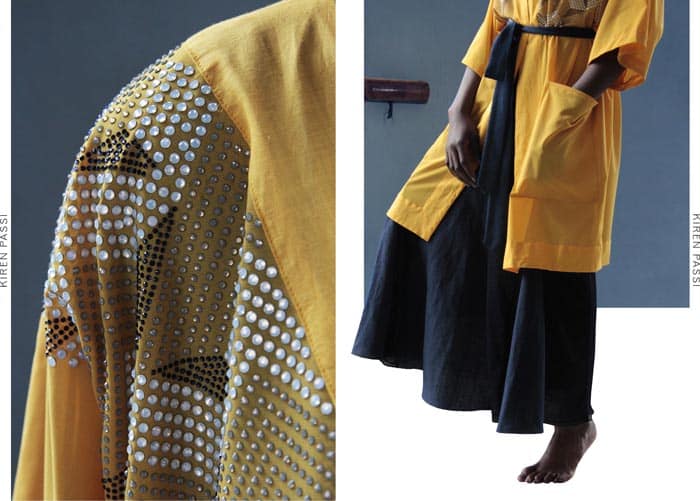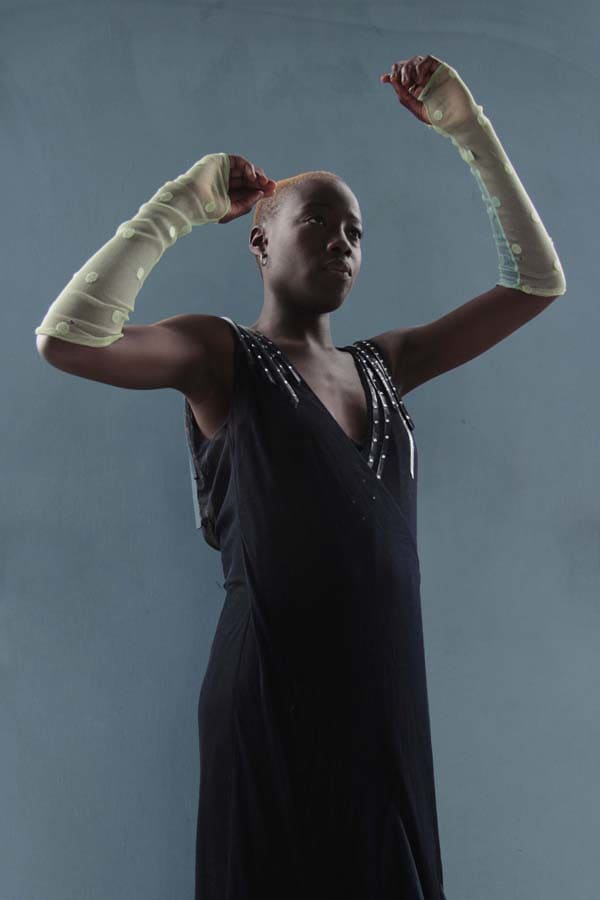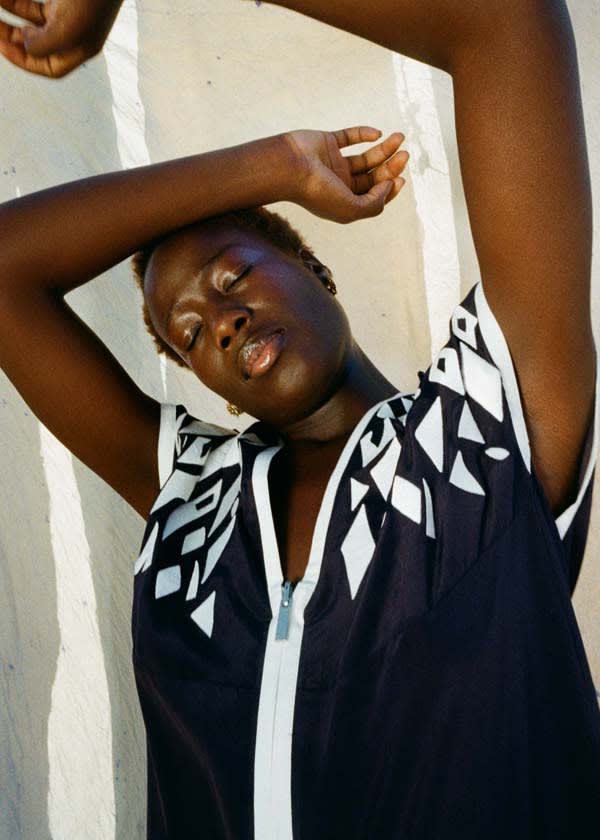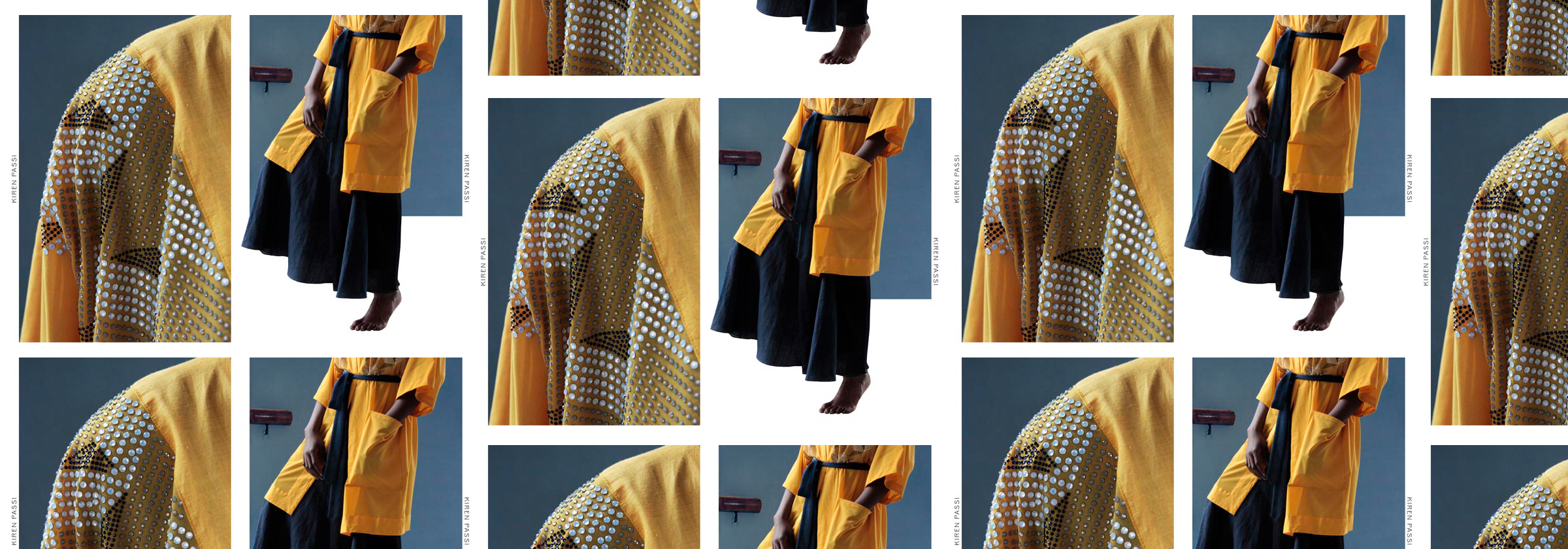
Part of a series of guest posts from the Centre for Fashion Enterprise (CFE) – words by Bethany Greer, Fashion Tech Project assistant at CFE.
The role of the fashion designer is not what it used to be – so how can students prepare? I sat down with Kiren Passi, an LCF and RCA grad, who landed a design internship at Dior before she even started her BA. Passi recently launched her namesake label after years of what can only be described as the modern day fashion designer hustle; taking on freelance work wherever she could, seizing international contracts and consulting projects.
Passi will be the first to tell you it takes more than a design degree to be successful – a combination of work and life experience are also essential to both achieving that ‘dream career’ and starting your own label.
We discussed everything from how to nail that first job to why competition amongst young brands “is just not realistic.”
You deferred your BA Hons. for a year to work at Christian Dior. How did you get that position and what made you reach out in the first place?
I recognised that having that year in industry was going to be really helpful, so that’s why I started contacting fashion houses and I managed to get an interview and went to Paris, I brought my portfolio and got an internship [at Dior.]
A lot of students are under the impression that being a designer is all very creative but of course, one of the most important things is not just being able to generate ideas but the actual execution. Work experience is really important for understanding that element. Is there any other way that students can simulate ‘real-word’ into their designs at school?
I mean I think you take your time but school is really precious because it is really about understanding your own research and identity and pulling that together to create something really creative. But, if you can pick up the skills, I’d say if you could pick up tailoring from Savile Row, for example, then include that in your collection in a really innovative way.
A lot of my identity is taking traditional embroidery skills and combining that with new innovative material. I think that if you could pick up skills in say, corsetry, I think your work would potentially go to another level of creativity. I think traditional handicraft skills are really important.
There’s a lot of steps that you go through before you actually develop the collection. Sometimes I feel like students miss that because they do the projects at uni and I don’t think they fully appreciate that the job of a designer is something very specific and there’s a process. It really is about idea generation of interesting, relevant design details and silhouettes.
So would you say it’s a combination of school and work experience that you need to get that first job?
Absolutely. My first job was as a fashion, womenswear designer- not an assistant. The owner of the company could rely on you to do the job because you’d already worked and done it.
Let’s talk about your experience working in many different countries. How did you navigate the cultural differences? For example, the differences between working in a studio in Italy compared to London, how do you deal with language barrier?
Language barriers are absolutely critical. In Italy I was given a tutor. Actually, what I found is even though I’ve worked in different countries, quite often the head design has been British and they’ve actually brought in a British team. A lot of John Galliano’s team were ex Central Saint Martins. In Bali it was a British director and owner and in Italy it was also a British. So the core language was always there with the people I needed to communicate with.
When I was in Italy though, I was based next to the atelier and all of the staff spoke Italian so I was given Italian lessons just so that I could understand. And the cultures was different in terms of the working day. We used to start early and finish late and then take a longer lunch break. A proper, more relaxed lunch break.

So how does that translate into how you work now?
Yeah I mean I used to be very much a late person but since getting into my mid-30s, I try to be a little more balanced. I try and live well, live healthily, do exercise and I have a plan of the week so what I’ll be doing at certain points of the day. I know when I’m best to do my e-mail, when I’m best to do my creative work. And obviously having a business you need to do a lot of visits and meetings so I try and plan it so that it suits my schedule where I feel I will get the most out of it during the week. So I think about it quite a lot.
You mentioned that these designers brought in a lot of UK talent, so what is it about London? Why has London been able to produce such great talent?
I think what sets them apart is research. The students are really encouraged to do deep research into their projects to have a knowledge of history and to think about what is relevant to them today in terms of politics. They have an opinion on politics and they’re expected to be aware of lots of films, directors and read really well. That’s something that I’ve noticed when I’ve been to universities outside of London, maybe it isn’t as important.
So now you have your own business, you are also freelancing. You’re working a number of different roles and we see a lot of emerging designers having to do that to stay afloat. Can you talk a little bit about how you balance between prioritising your own business as well as keeping up with freelance work?
Well now I’ve got a two-day a week paid role at UAL, so actually it’s very clear. Two days a week I will be lecturing and working with the industry to place students. I have three days to work on my collection. That means what I’m working on my collection, I’m really focused and probably more confident because I’m confident I have stability through my UAL role. So I think it’s enhancing my individual practicing creativity.
Beyond young designers starting their own brand, we’re seeing big designers have multiple roles and be very multidisciplinary. For example Virgil Abloh at Off-White and Louis Vuitton Men’s also DJing, designing furniture for IKEA. By trade, he was actually an architect. Do you think it’s easy to come into the fashion world without any training if you have a strong enough style? Do you have any strategies to translate your style from another art-form into clothing design?
I mean it goes back to that whole thing of, ‘what design is.’ There is a skill set within design. A lot of these companies you know, like Victoria Beckham, will employ designers that have got this skill set.
If you’re a really creative person, you probably need to collaborate with someone who’s got the skill set which is designing, actually drawing, then being able to fit on the model and go through the production process. If you’re someone that’s got a really strong style and you want to do that, you can try and pick it up from scratch. It might take some time and there will be a bit of trial and error. With that trial and error it’s very expensive because every time you make a mistake, you’ve got to pay for it. Or, you decide that you want to invest in someone who’s already got that skill set and you work with them and collaborate but again, that’s going to be an immediate investment. I guess the other way that you could do is I mean, like Henry Holland who just started with T-shirts. If your thing is you’re really good with wording, or something like that, then apply that in a way that’s simpler to use.
Young people now have a lower barrier to entry into the industry, with digital and social media, you can easily put yourself out there. But at the same time it makes it much harder to achieve success. How do you employ social media and digital in your business to differentiate yourself while remaining authentic to your brand DNA?
Well we’ve developed a social media plan since being on this [CFE] programme. I’ve got clear guidelines as to what I want to say because a lot of the tone of my social media launching in January is going to be very technical, sort of no nonsense. I don’t want to do the frills, I’m very much about placement of details, material development, silhouettes, and innovation. Less is more to me. I don’t need to post five things a day, I just need one that’s really strong and that’s got some sort of an enhanced message in it.

It’s very apparent now that you can’t just have a great product. There has to be more personality behind your brand, there has to be a larger message. A lot of brands are using different social enterprise business models or are working with charities, for example. At what point does it lose its authenticity?
A lot of these social enterprises that we support, we do work with a charity in Nottingham, but it’s not necessarily the first message you’ll see on our social media. When it’s appropriate for both parties, we would talk about it and again, in very much a no nonsense straight message kind of way. And we are doing these things you know, we’re looking into sustainable practices all the time, we’ve worked a lot with sustainable materials in the past but it’s not going to be the first message.
Are you tracking the impact of the sustainable materials as opposed to conventional? In terms of water consumption, CO2 emissions for example?
A lot of that’s already done through the manufacturer of the material. So if it was using recycled material, they would already note that before we order it.
What do you find exciting about using technology to, in your case, further textile innovation?
Yeah it’s for me, because I’ve come from this, I guess traditional fashion background, I’ve been exposed to a lot of these traditional embroidery techniques throughout my career. I’ve worked with craft communities in Bali, India and Nepal. So for me, it’s really exciting to take that history and culture and then combine it with all of these new materials I’ve started to do since I did my MA the Royal College of Art. I work in new studios like the resin room and the silicon room and then combine the two to try and understand where we are at the moment, to reflect on what’s happening in the industry.
I think it’s a really great skill to be able to work with artisans and be able to achieve a final product that echoes the initial product you had in your mind. When it comes to students, there’s that thought that conceiving the idea is the most difficult part but actually, being able to lead a team and lead artisans to develop a cohesive product is very difficult. What were some of the biggest challenges that you came across during your time in Bali and Nepal that you didn’t even consider until actually being there on the ground?
In Nepal I was given a scholarship to go and work with a group of farmers who work with a particular embroidery called the ‘Sangtang’ embroidery in a certain part of East Nepal. So it was a trek to even get up there and meet them. The challenges were things like, the artisans were very used to doing the same embroidery, so we introduced new colors and also I set a challenge to create the embroidery on a much larger scale. That then meant that I had to develop a tool for them to be able to do that. These new ways of working were slightly more challenging for them because they were used to doing this embroidery whilst out in the farms, it was just a way of making extra income. They weren’t thinking about the innovation behind how the embroidery could be used for the expat market and five star hotels. Another challenge is really respecting the artisans for their creativity. I didn’t want to dictate how the designs should be done because although we had a knowledge of the Western market, it was still where they had the ownership so it was a very sensitive collaboration.
Let’s get back to your current brand. You’re doing a hybrid launch which is through the Seekers of Design Platform and through wholesale. Wholesale margins can really can really kill young designers so how do you navigate that, do you ask for a percentage up front?
Yeah I mean ideally I want 30 percent upfront but at this stage, a lot of the stores want consignment sale-return because they’re still testing. My initial range was so small, it was only 10 pieces, so I’m fine with that initially but obviously when I start to get more orders, then I would need 30 percent to pay for the production.
Has starting your own brand been what you thought it was going to be like?
I think so yeah, it’s pretty much what I was expecting. Maybe slightly more overwhelmed by the amount of business, admin, meetings that really encroach on your working week. That’s why I’ve got to be really careful, I allocate design time every day so that I push the product forward because ultimately, that’s really important.
So one thing that always comes up as advice for young people entering this industry is that the path you think you’re going to take is never the one that you actually do. With this in mind, what other advice would you give to students and early-stage designers?
I was really unaware of a lot of the companies that I worked for but once I was on a career ladder, I had agents introducing me to companies and countries. I’d say ‘if the job’s right, I’m available to travel.’ I was excited to see the world and didn’t have any responsibilities keeping me to London so I’d say, just be open to all opportunities.
The other thing that’s important is it’s easy to get quite caught up in what everyone else is doing and there’s so many people trying to do the same thing as you are. It’s really important to not compare because no one’s path is going to be the same.
I feel that competitiveness or jealousy or all of those things are just not realistic. You’ve come from your own place, you’ve got your own heritage, you’ve got your own history, your own challenges and wins. So you can only be competitive against yourself. Collaborate- if someone’s doing something similar to you, hook up with them and build yourselves a movement.
Follow Kiren:
Instagram: @kirenpassii
Website: www.kirenpassi.com
Kiren Passi was recently on Centre for Fashion Enterprise’s FashTech Pioneer programme, a six-month programme which supports fashion technology entrepreneurs who want to redefine the future of the industry.

